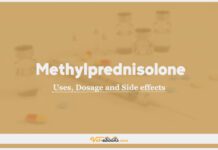Dexamethasone: Uses, Dose and Side Effects For Dogs, Cats & All Animals

Overview
- Modifies the transcription of DNA, resulting in changes in cellular metabolism that reduce the inflammatory response.
Uses of Dexamethasone For Dogs, Cats & All Animals
In Dogs and Cats:
- Anti-inflammatory drug: To reduce inflammation in various conditions.
- Assessment of adrenal function: Used in dexamethasone suppression tests to diagnose hyperadrenocorticism (HAC).
- Emergency treatment of hypoadrenocorticism: Provides immediate glucocorticoid support in critical cases.
- Anaphylaxis: Prevents and treats allergic reactions associated with transfusion or chemotherapeutic agents.
In Other Animals:
- Horses: Used for the treatment of inflammatory conditions like arthritis, dermatitis, and uveitis. It is also utilized for managing allergic reactions and as part of diagnostic testing for equine Cushing’s disease.
- Cattle: Employed in the treatment of inflammatory conditions and to reduce the swelling associated with udder edema in postpartum cows.
- Sheep and Goats: Used to control inflammation and to manage shock in critical care settings.
- Swine: Administered to reduce inflammation, manage shock, and in cases of severe allergic reactions.
Dose of Dexamethasone For Dogs, Cats & All Animals
| Species | Condition | Dosage |
|---|---|---|
| Dogs | Ophthalmic | Apply ointment every 6–24 hours or 1 drop every 6–12 hours. |
| Otic | 10 drops in the ear once daily for 7–14 days. | |
| Cerebral edema | 0.1–0.3 mg/kg for anti-inflammatory effects. | |
| Hypoadrenocorticism | 0.2 mg/kg i.v. daily until oral medication is possible. | |
| Inflammation | 0.01–0.16 mg/kg i.m., s.c., or p.o. every 24 hours for 3–5 days. | |
| Anaphylaxis | 0.5 mg/kg i.v. once. | |
| Immunosuppression | 0.3–5 mg/kg i.m., s.c., or p.o. every 24 hours for up to 5 days. | |
| Cats | Same as dogs (ophthalmic, cerebral edema, inflammation, etc.) | Refer to relevant dog doses. |
| Adrenal function assessment | 0.1–0.15 mg/kg i.v. | |
| Horses | Anti-inflammatory | 0.02–0.2 mg/kg i.m., i.v., or p.o. based on severity. |
| Shock or systemic inflammation | 0.05–0.2 mg/kg i.v., adjusted based on response. | |
| Cattle | Inflammation | 0.04–0.1 mg/kg i.m. or s.c. |
| Sheep & Goats | Shock management | 0.1–0.2 mg/kg i.v. |
| Swine | Inflammation | 0.04–0.1 mg/kg i.m. |
Drug Dosage Calculator
You Should Give:
Side Effects of Dexamethasone For Dogs, Cats & All Animals
- Dogs and Cats:
- Adrenal Suppression: One dose can suppress adrenal gland activity for up to 32 hours.
- Inhibition of the HPA Axis: Long-term use can cause adrenal atrophy.
- Metabolic Changes: Increased liver enzyme activity, weight loss, PU/PD, vomiting, and diarrhea.
- Gastrointestinal Irritation: Risk of ulceration with prolonged use.
- Hyperglycemia: Can result in increased blood glucose levels.
- Horses: Prolonged use or high doses can increase the risk of laminitis. Monitoring for early signs is essential during treatment.
- Cattle: Long-term administration can lead to immunosuppression, reduced milk production, and metabolic disturbances.
- Sheep and Goats: Possible side effects include immune suppression and delayed wound healing with prolonged use.
- Swine: Gastrointestinal irritation and immune suppression are potential risks, particularly with high doses or extended treatment.
Contraindications of Dexamethasone For Dogs, Cats & All Animals
- Dogs and Cats:
- Pregnancy: Risk of fetal abnormalities.
- Renal Illness and Diabetes: Use cautiously in patients with these conditions.
- Infections: May exacerbate infections and slow wound healing.
- Ulcerative Keratitis: Contraindicated for topical use in the eyes when corneal ulcers are present.
- Horses: Contraindicated in cases of laminitis or risk thereof. Use cautiously in pregnant mares as it may lead to abortion.
- Cattle: Avoid in cases of infection, particularly mastitis, due to its immunosuppressive effects.
- Sheep and Goats: Should be used cautiously in pregnant animals as it may induce premature labor.
- Swine: Avoid in piglets with a weak immune system or those suffering from viral infections.
Some Notes:
- Potency: 0.15 mg of dexamethasone is equivalent to 1 mg of prednisolone.
- Tapering: Gradual reduction is necessary when discontinuing after long-term use.
- Drug Interactions:
- Dogs and Cats: Concurrent use with NSAIDs increases the risk of GI ulceration. May interact with amphotericin B, diuretics, insulin, phenytoin, and itraconazole.
- Horses: Using dexamethasone with NSAIDs can increase the risk of gastrointestinal ulceration. Combining with insulin may require dose adjustments due to dexamethasone’s antagonistic effects.
- Cattle, Sheep, and Goats: Interactions with diuretics (e.g., furosemide) may increase the risk of hypokalemia. Co-administration with vaccines may reduce vaccine efficacy due to immunosuppression.
- Swine: Caution is advised when used alongside drugs that affect electrolyte balance, as dexamethasone may exacerbate electrolyte disturbances.
- Long-term Therapy: Not recommended for long-term daily use due to potential adverse effects.
Tip
Do You Want To Increase Your Veterinary Knowledge and Practical Skills?
You Can Now Browse and Download +3000 Books For Veterinary Professionals & Students Online.
Download Veterinary Books



















